You are viewing 1 of your 1 free articles
Scanning and practice design
The focus of this session is to explore the different types of practices that may develop players’ scanning behaviour.
| Area | Up to full pitch |
| Equipment | Balls, bibs, cones, 2 full size goals |
| No. of Players | 20 players + 2 goalkeepers |
| Session Time | Practice 1: 20mins Practice 2: 20mins |
Research has recognised the important role that perceptual cognitive skills play in skilled football performance. Studies based on scanning have revealed this behaviour has a significant impact on performance with the ball, resulting in higher pass accuracy, maintaining possession better, encouraging forward passes, creating opportunities to turn, and receiving under less defensive pressure. Despite this, little research has investigated effective practice design to develop the frequency and quality of scanning.
Rather than being an entire session, the activities presented here are practice ideas that could be used across a range of different sessions. They include examples of several different kinds of practices – non-active decision making practices, small-sided games and conditioned games. Some of these practices could also be used by coaches for warm up activities.
“Studies based on scanning have revealed this behaviour has a significant impact on performance with the ball, resulting in higher pass accuracy, maintaining possession better, encouraging forward passes, creating opportunities to turn, and receiving under less pressure”
PRACTICE 1
We set up a playing area of 30x30 yards. We’re using 16 outfield players split into four teams of four – blues, reds, yellows and greens. Each team has a set of four bibs with a different shape on each one – a cross, a circle, a square and a triangle, therefore each player on each team is wearing a different shape.
There are four balls in the area. Players move freely in the area, passing the balls between them, irrespective of the colour bib they are wearing or the shape on it, as shown [1a].
[1a]
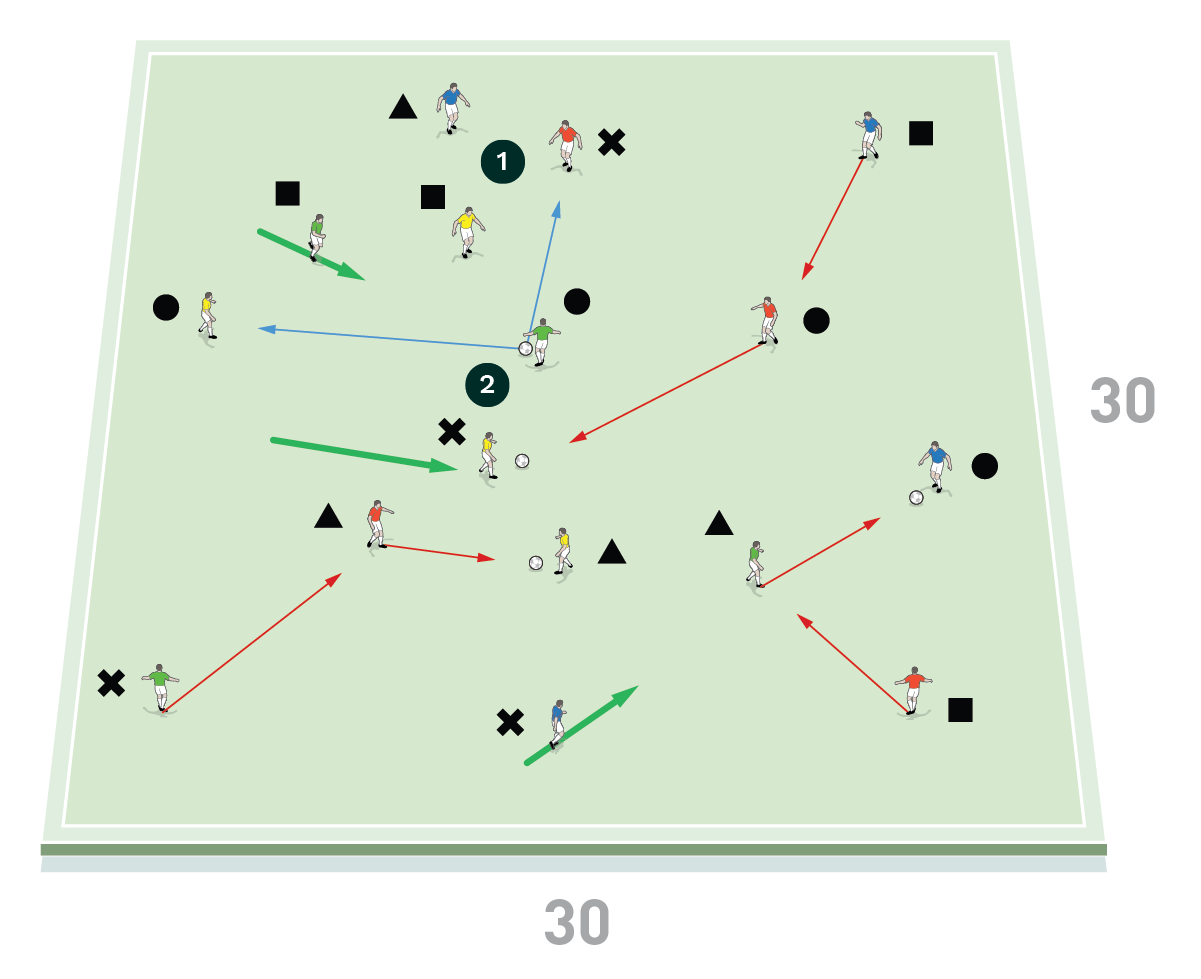
- Each team has a set of four bibs and each bib has a different shape on it – a cross, a circle, a square or a triangle
- There are four balls in the area. Players initially move freely, passing the balls irrespective of their colour bib or the shape on it. The aim is to maintain possession of the four balls in the playing area
The aim is to maintain possession of the football in the playing area. We play this for five minutes.
Next we add two five-yard end zones, making the playing area 40x30 yards. There are four balls in play and players work in teams defined by the shape on their bib. Teams must keep possession of the ball while working it to a position where they can pass to a player in an end zone. When they achieve this, they must then turn and attack the opposite end zone in the same manner, as shown [1b].
[1b]
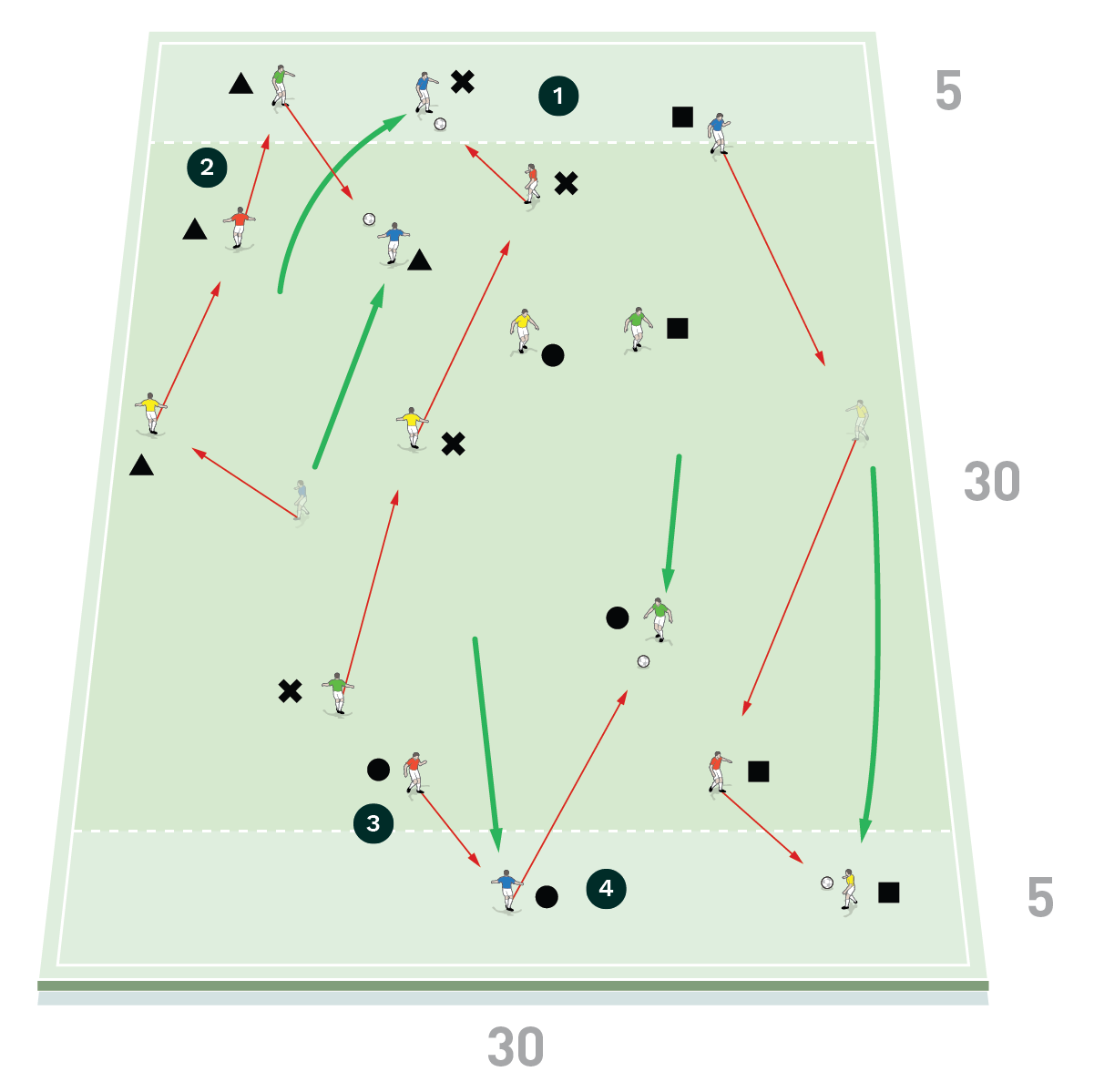
- Two five-yard end zones are added
- There are four balls in play and players work in teams defined by the shape on their bib – here the triangles work together as a team
- Teams must keep possession while working the ball to a position where they can pass it to a player in an end zone
- If they succeed in passing into the end zone, they must then turn and attack the opposite end zone in the same manner
We play this for five minutes.
The end zones are then removed, making the playing area 30x30 yards once again. There are still four balls in play, but this time players must pass the ball in the following sequence: circle, triangle, square, cross, circle… and so on, as shown [1c].
[1c]
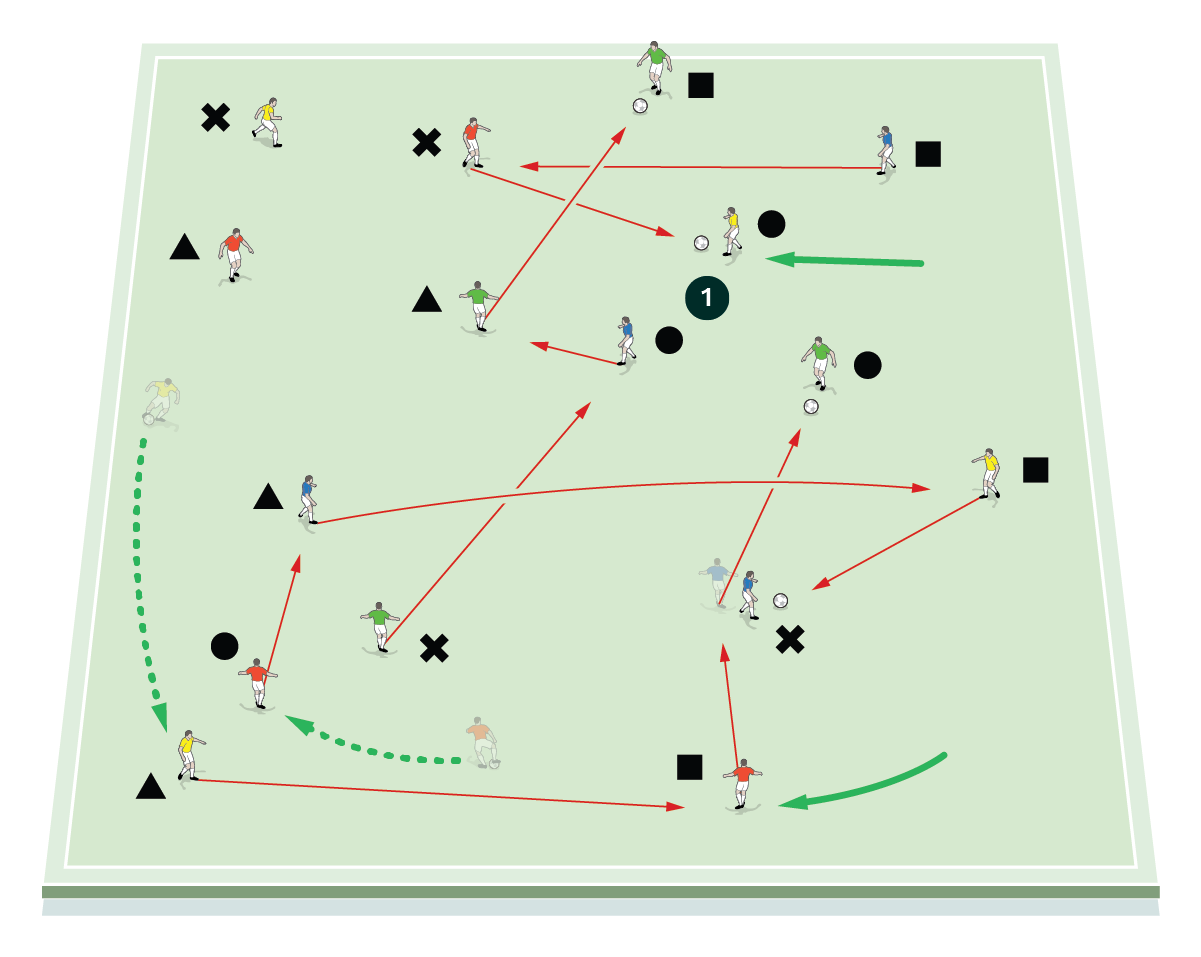
- There are four balls in play, but this time players must pass in the following sequence: circle, triangle, square, cross and then circle again
We play this for five minutes.
Using the same 30x30 yard area, we run the next stage of the practice. There are still four balls in play at the same time. Players are now free to pass the ball to any other player in the area but prior to receiving the ball, a player must call out the shape on the bib of the nearest player, as shown [1d].
[1d]
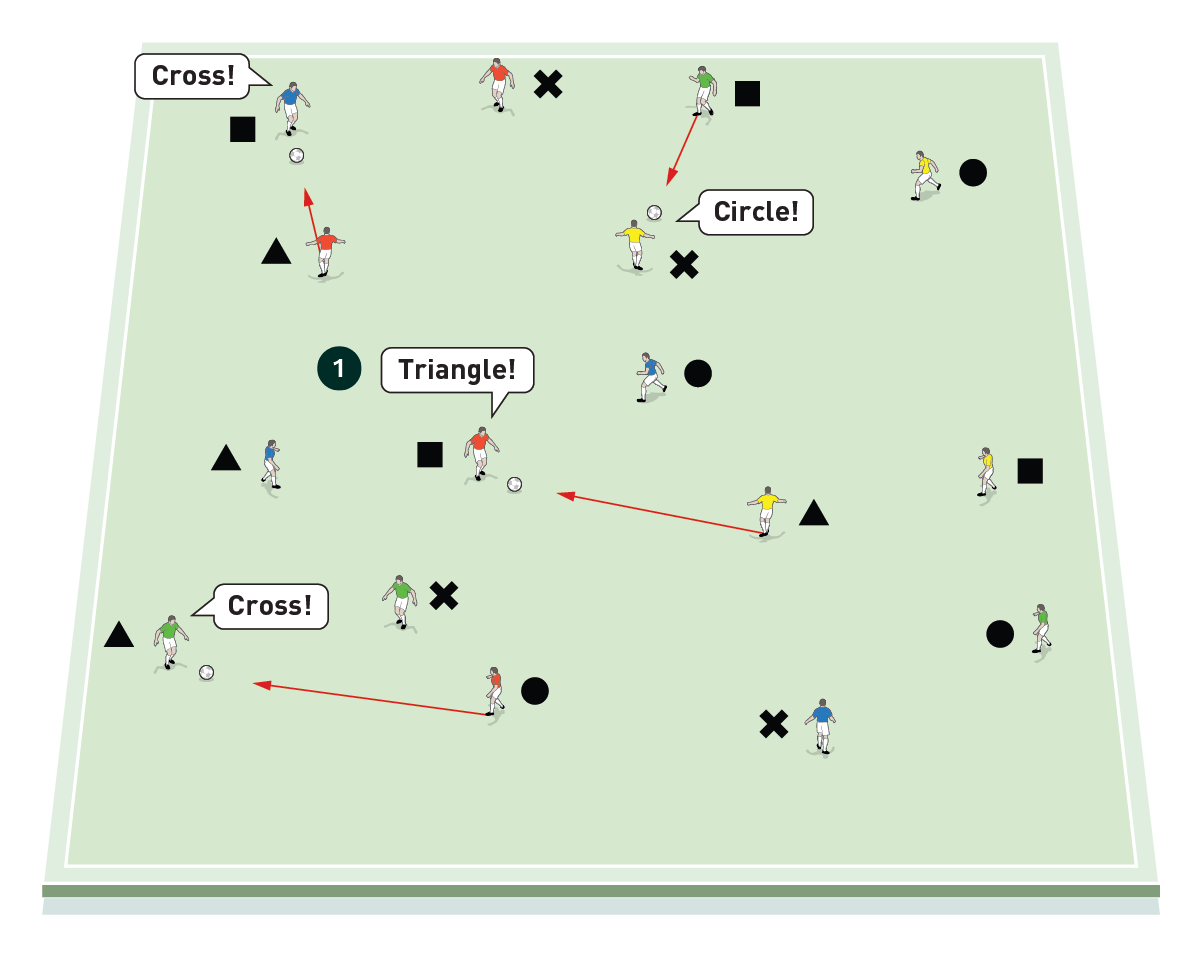
- There are four balls in play, but this time players must pass in the following sequence: circle, triangle, square, cross and then circle again
We play this for five minutes.
When play restarts, there are still four balls in play. In this stage players are free to pass to any other player in the area but prior to receiving the ball, a player must call out the shape on the bib of the furthest player from them, as shown [1e].
[1e]
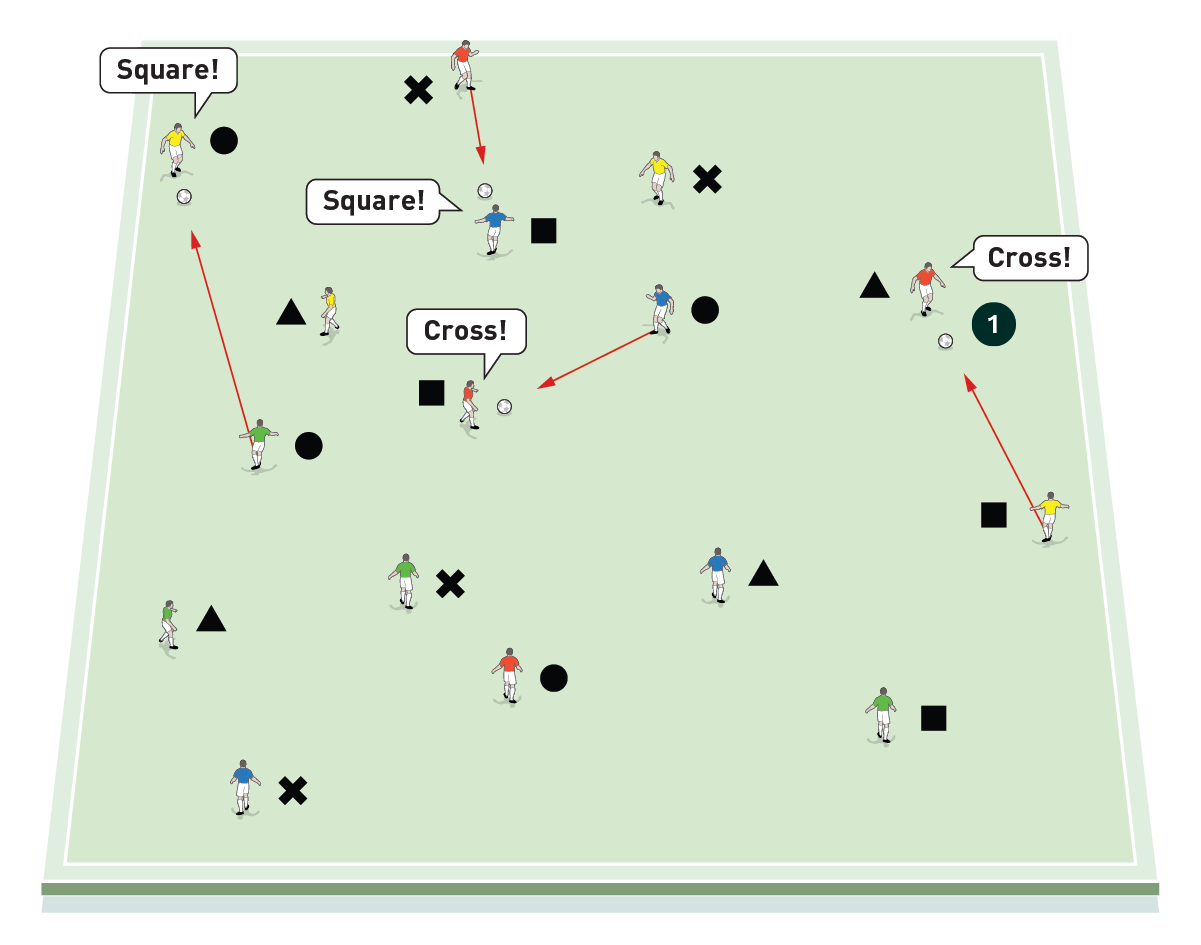
- There are still four balls in play. Players are free to pass to any other player in the area but prior to receiving the ball, a player must call out the shape on the bib of the furthest player
We play this for five minutes.
Progressions for Practice 1: To increase decision making introduce four tennis balls. Each colour team has possession of one tennis ball and must throw this between them as well as sending and receiving the football. Players can be challenged further by the tennis ball moving between the same-coloured bibs, but the footballs must now be sent between the same shaped bibs. Players must scan and support for the different types of ball whilst still making decisions about when to pass or dribble with the ball, alongside deciding on the weight and accuracy of the pass. This is all being performed unopposed, but the level of decision making is increased.
The ideas for practice 1 were developed from a research study conducted in 2014. The aims of the study were twofold: (1) to explore soccer coaches’ perceptions of scanning; (2) to investigate the impact of non-active decision making (unopposed) and active decision making (opposed) practices on the scanning behaviour youth soccer players.
The findings revealed that 11 out of 17 practices that were suggested by the coaches were classified as non-active decision making practices. Players then participated in a series of non-active decision making practices and an active decision making practice that the coaches had suggested. In the non-active decision making practices players wore different coloured bibs that had shapes on them. The players were significantly more likely to perform scanning when participating in the non-active decision making practices compared to the active decision making practices.
PRACTICE 2
We set up a playing area of 30x30 yards. We’re using eight outfield players split into two teams of four – the reds and the blues. There are two balls in play – each team starts with a ball and they pass to keep possession. The aim for each team is to have possession of both balls. Once a team is in possession of both balls, they can score a point by making passes that result in the balls colliding together.
In the first diagram below, the red team is in possession of one ball and then wins the second ball from the blue team after intercepting a pass, as shown [2a].
[2a]
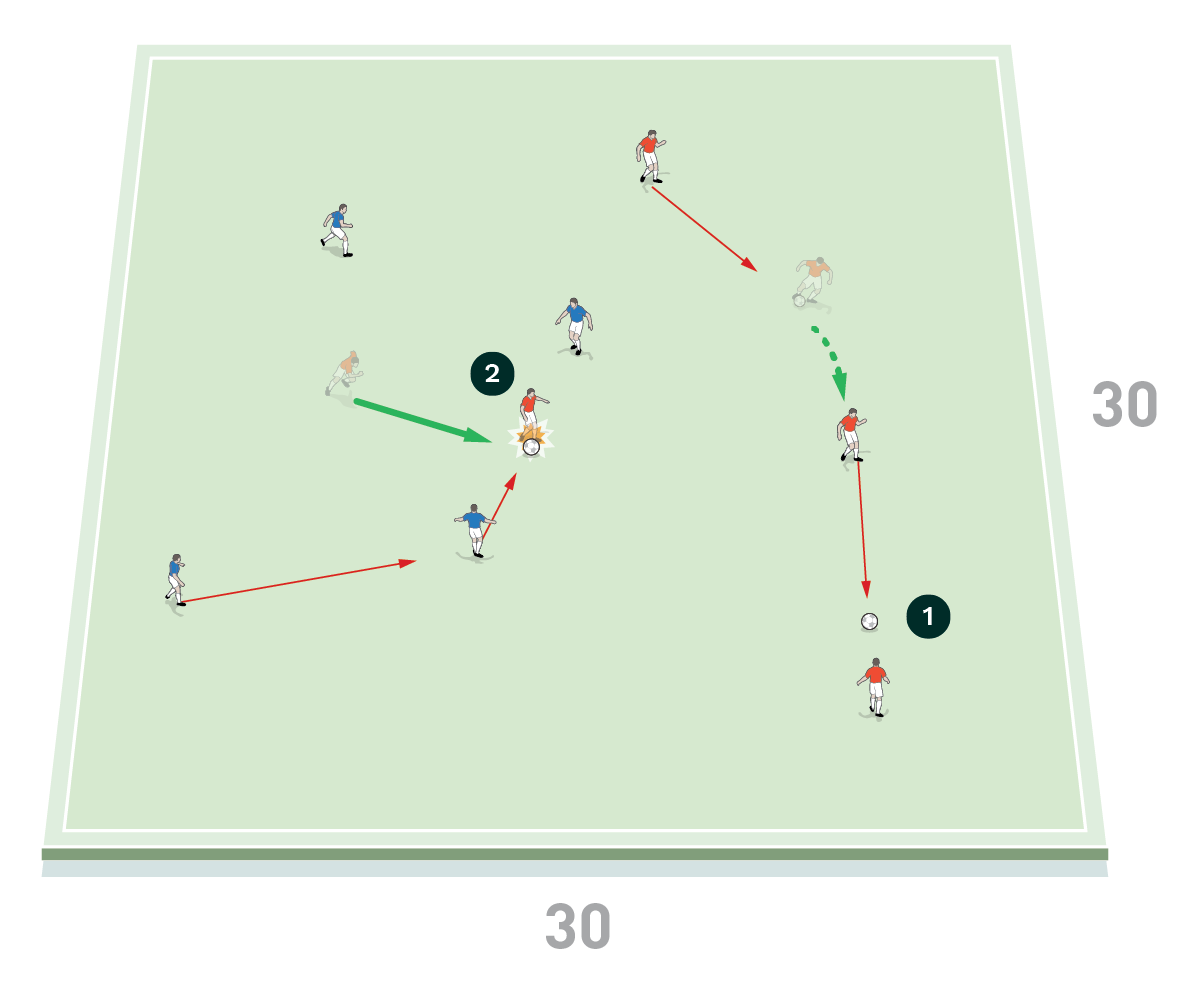
- Each team passes a ball to keep possession. Here the reds pass their ball
- Here the reds win the second ball from the blue team after intercepting a pass
The blue team then looks to win both balls back from the red team but the reds gain an extra point by passing the balls so they collide together, as shown [2b].
[2b]
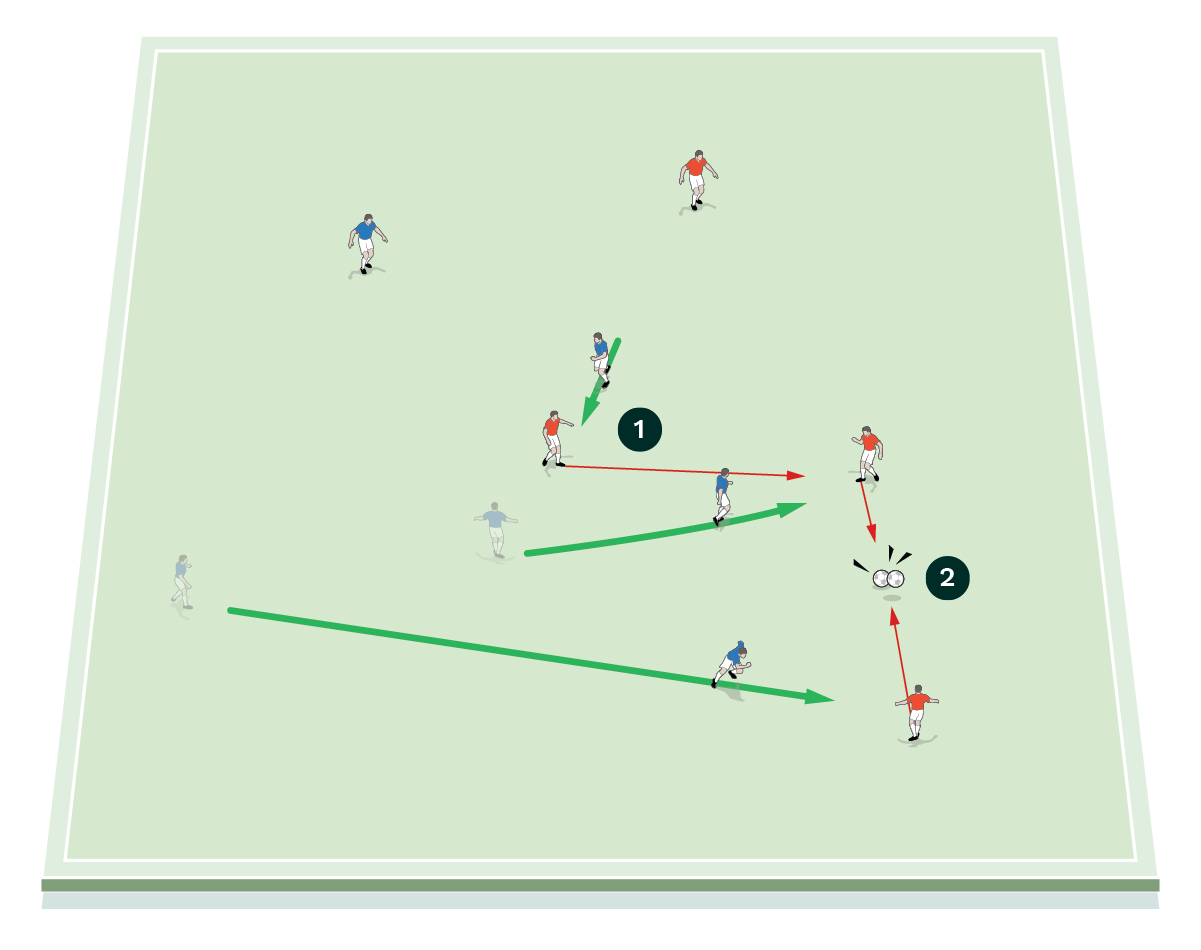
- After losing possession of their ball, the blues look to win both balls back from the red team
- The reds gain an extra point by passing the balls so they collide together
Play then continues in the same fashion. We play for 15 minutes.
In this game, the out-of-possession players must continuously scan the playing environment to decide whether to support their team mates in possession or try and win possession to score a point.
PRACTICE 3
We set up a central playing area of 80x64 yards with a full size goal at each end of a pitch. A pair of 10-yard pole gates are added at each end – they are placed in line with the edge of the penalty area and positioned on each side of the pitch.
We’re using 16 outfield players split into two teams of eight and we play a conditioned 8v8 game. Goalkeepers can be used if desired, but we are not using them here. The team in possession must build up play with the aim of scoring in the goal at the end they are attacking, but one of their players must first make a run through one of the gates to receive a pass before crossing for a team mate to run onto and shoot, as shown [3a].
[3a]
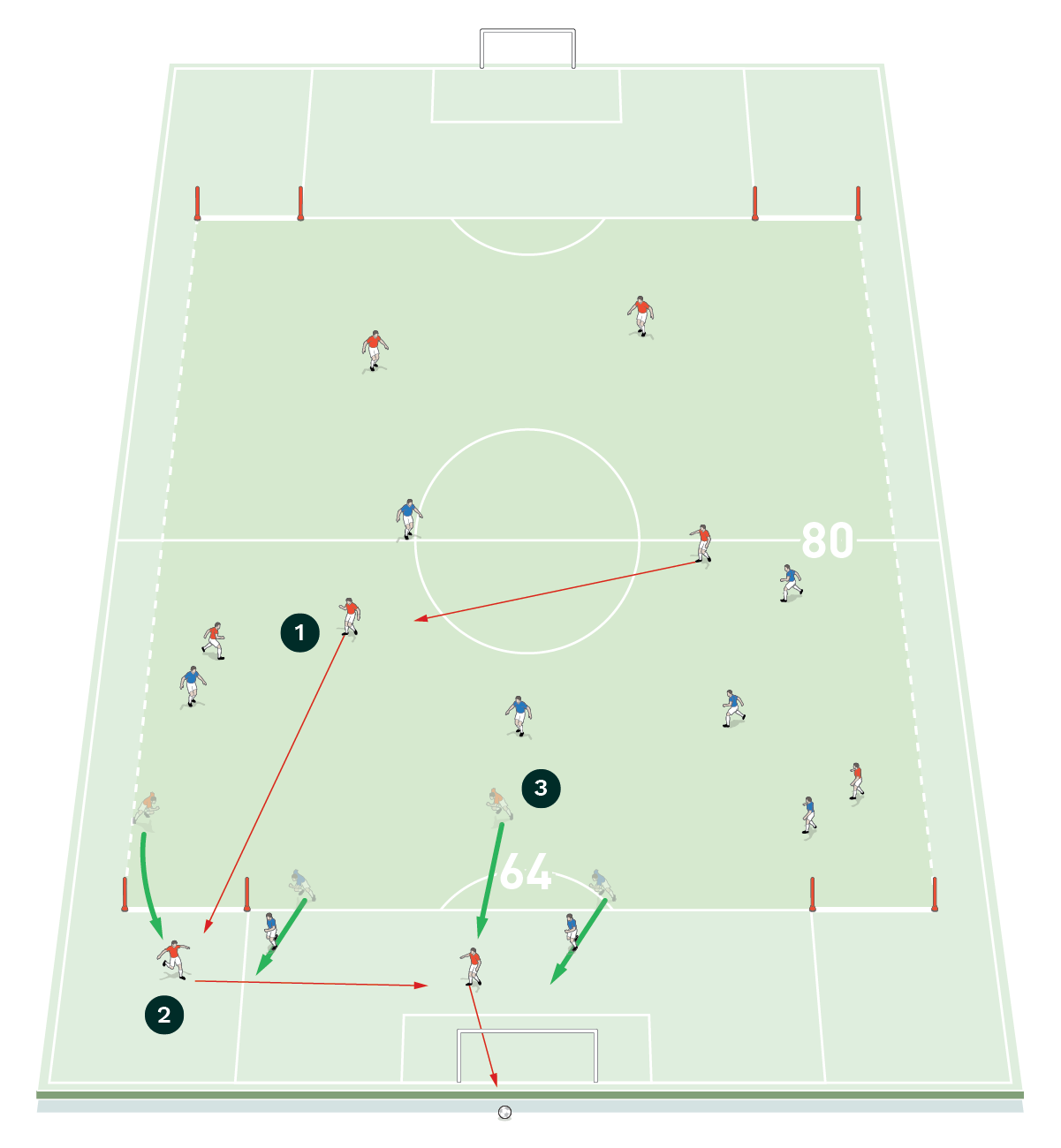
- The team in possession must build up play with the aim of scoring in the goal at the end they are attacking
- For a goal to count one of the attacking players must first make a run through a wide gate to receive a pass before crossing
- Here an attacker makes a forward run to meet the cross and shoots
To be successful, players need to think about how they create space in wide areas – for instance, by drawing opposition players centrally or to one side of the pitch. Players will have to try and manoeuvre the defensive team to create space to attack and score. They will need to be visually aware of the positioning of defensive players to make the correct decision about when and where to attack. We play for 15 minutes.
As a progression, a central gate can be added on the 18-yard line at each end. In this progression players get one point for travelling through one of the wide gates and crossing for a team mate to score or three points for travelling to receive a pass through the central gate and scoring with a shot, as shown [3b].
[3b]
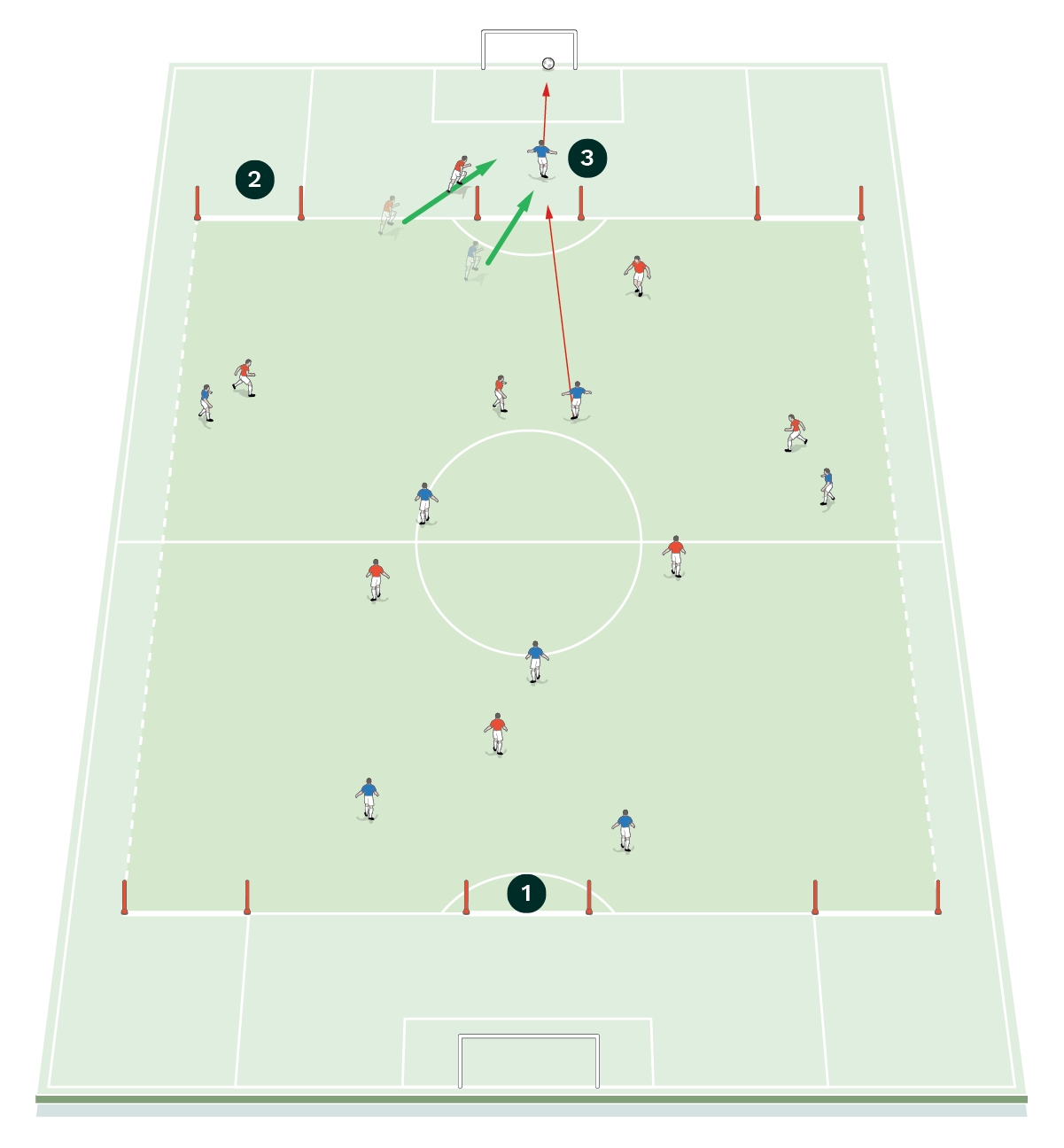
- As a progression, a central gate can be added on the 18-yard line at each end
- Teams get one point if a player travels through one of the wide gates and crosses for a team mate to score
- Teams get three points if a player travels to receive a pass through the central gate and scores with a shot on goal
Players in possession now need to scan the playing environment to decide on which goal they should attack. This will depend on the position of defenders and their team mates.
COACHING POINTS
What are the key things to look for?
It is fundamental that coaches observe whether the players are actively and temporarily moving their head and/or body away from the ball with the intention of looking for space, team mates, the opposition and the ball and their subsequent actions in and out of possession.
What are the typical mistakes players might make and how do I avoid them?
The most common mistake players make is moving their head frequently but not actually looking and taking in information from the surrounding environment. Coaches could use questioning to check what information players are taking in when they perform their scanning behaviour.
Related Files
Editor's Picks
Deep runs in the final third
Using the goalkeeper in build-up play
Pressing principles
Intensive boxes drill with goals
Penetrating the final third
Creating and finishing
My philosophy
Pressing initiation
Compact team movement
Coaches' Testimonials

Alan Pardew

Arsène Wenger

Brendan Rodgers

Carlos Carvalhal

José Mourinho

Jürgen Klopp

Pep Guardiola

Roy Hodgson

Sir Alex Ferguson

Steven Gerrard
Coaches' Testimonials

Gerald Kearney, Downtown Las Vegas Soccer Club

Paul Butler, Florida, USA

Rick Shields, Springboro, USA

Tony Green, Pierrefonds Titans, Quebec, Canada
Join the world's leading coaches and managers and discover for yourself one of the best kept secrets in coaching. No other training tool on the planet is written or read by the calibre of names you’ll find in Elite Soccer.
In a recent survey 92% of subscribers said Elite Soccer makes them more confident, 89% said it makes them a more effective coach and 91% said it makes them more inspired.
Get Monthly Inspiration
All the latest techniques and approaches
Since 2010 Elite Soccer has given subscribers exclusive insight into the training ground practices of the world’s best coaches. Published in partnership with the League Managers Association we have unparalleled access to the leading lights in the English leagues, as well as a host of international managers.
Elite Soccer exclusively features sessions written by the coaches themselves. There are no observed sessions and no sessions “in the style of”, just first-hand advice delivered direct to you from the coach.







